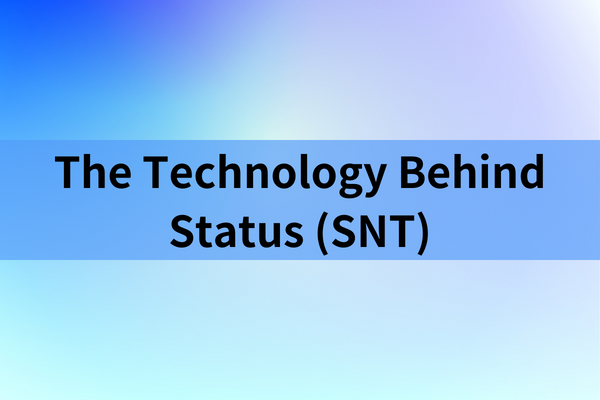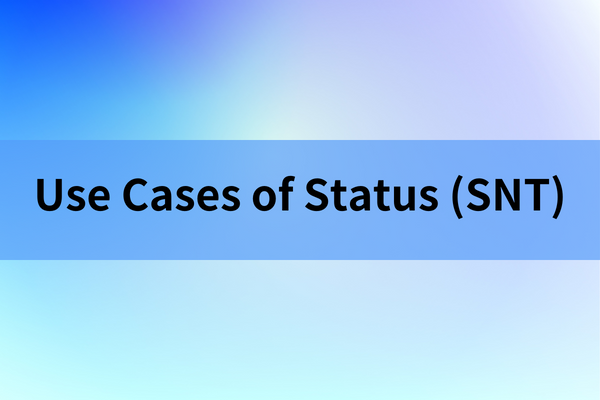Cryptocurrencies have disrupted traditional financial systems and sparked a revolution in the world of finance and technology. Among the multitude of cryptocurrencies in existence, Status (SNT) has emerged as a promising project with a unique approach. In this article, we will delve into the intricacies of Status (SNT) cryptocurrency, exploring its history, technology, use cases, and the potential it holds for the future.
Detailed Articles are here
目次
The Genesis of Status (SNT)
|
Name |
Status |
|
Token Symbol |
SNT |
|
Price |
$83,848,128 |
|
Official page |
|
|
X(Twitter) |
Status, abbreviated as SNT, is a cryptocurrency that was introduced to the world in 2017. The project was developed with the aim of creating a decentralized platform for communication and web browsing. Status founders Carl Bennetts and Jarrad Hope envisioned a future where people could interact with decentralized applications (DApps) and communicate securely while retaining control over their data and privacy.
SNT tokens were designed to play a pivotal role within the Status ecosystem. Users can stake SNT tokens to access various features of the platform, such as creating and participating in decentralized chat groups and accessing decentralized applications.
The Technology Behind Status (SNT)

Ethereum-Based
Status (SNT) is built on the Ethereum blockchain, making it an ERC-20 token. Ethereum, with its smart contract capabilities, provides the foundation for a wide range of decentralized applications, and Status leverages this technology to create a decentralized communication and web browsing platform.
Whisper Protocol
One of the standout features of Status is its integration of the Whisper protocol. Whisper is Ethereum’s messaging protocol, designed to facilitate secure, private, and decentralized communication. This protocol ensures that messages are end-to-end encrypted and that metadata is stripped away, enhancing user privacy and security.
Decentralized Identity
Status also introduces the concept of decentralized identities, allowing users to control their digital personas without relying on centralized authorities. This aligns with the broader blockchain ethos of returning control of data to individuals.
Use Cases of Status (SNT)

Secure Messaging
At its core, Status provides users with a secure and private messaging platform. Users can send messages, files, and even cryptocurrency transactions through the app. The encryption ensures that messages are only visible to the intended recipients, eliminating the risk of data breaches or surveillance.
Access to Decentralized Applications (DApps)
Status serves as a gateway to the world of DApps. Users can explore, interact with, and use various decentralized applications from within the Status app. This seamless integration makes it easier for users to embrace the decentralized ecosystem.
Staking and Governance
SNT tokens are not just a means of payment within the platform; they also have a governance role. Token holders can stake their SNT to participate in decision-making processes related to the development and direction of the Status ecosystem. This mechanism ensures that the community has a say in the platform’s evolution.
Challenges and Controversies

No cryptocurrency project is without its challenges and controversies, and Status is no exception. One of the most notable issues faced by Status is scalability. As an Ethereum-based project, Status relies on the Ethereum network, which has experienced congestion and scalability challenges during periods of high demand. This can lead to slower transaction times and higher fees.
Additionally, the project faced criticism for the delay in delivering some of its promised features, leading to frustration among early supporters.
Recent Developments

Despite the challenges, Status has continued to evolve and adapt to the changing crypto landscape. The team has been actively working on improving scalability and usability. One notable development is the integration of the Status app with Layer 2 solutions on the Ethereum network, which aims to address the scalability issues by conducting most transactions off the main Ethereum chain.
Moreover, the team has focused on enhancing user experience and expanding its ecosystem of decentralized applications.
Potential Future Growth
Mass Adoption
Status’s vision of a decentralized communication and web browsing platform aligns with the growing demand for privacy and control over personal data. As concerns about data privacy and surveillance continue to rise, decentralized platforms that prioritize user control may gain more traction.
Integration with DeFi
The DeFi (Decentralized Finance) space has seen explosive growth, and Status could play a role in bridging the gap between traditional financial systems and decentralized applications. Integration with DeFi platforms could open up new avenues for financial services within the Status ecosystem.
Continued Innovation
The cryptocurrency space is highly dynamic, with new technologies and concepts constantly emerging. Status has shown a commitment to innovation, and its future growth may involve adopting or developing new technologies that enhance its capabilities and user experience.
Conclusion
Status (SNT) cryptocurrency, with its focus on decentralized communication and web browsing, represents a unique approach to blockchain technology. While it has faced challenges and controversies, its integration of the Ethereum blockchain, Whisper protocol, and emphasis on user privacy make it a project worth watching.
As the crypto space continues to evolve, Status’s commitment to innovation and its potential to bridge the gap between DeFi and traditional systems could position it for significant growth and adoption in the coming years. Only time will tell if Status will realize its vision of a decentralized internet, but its journey thus far is a testament to the ever-expanding possibilities of blockchain technology.





